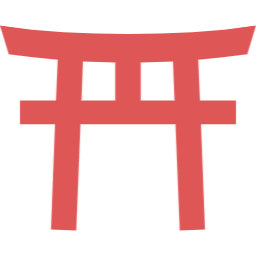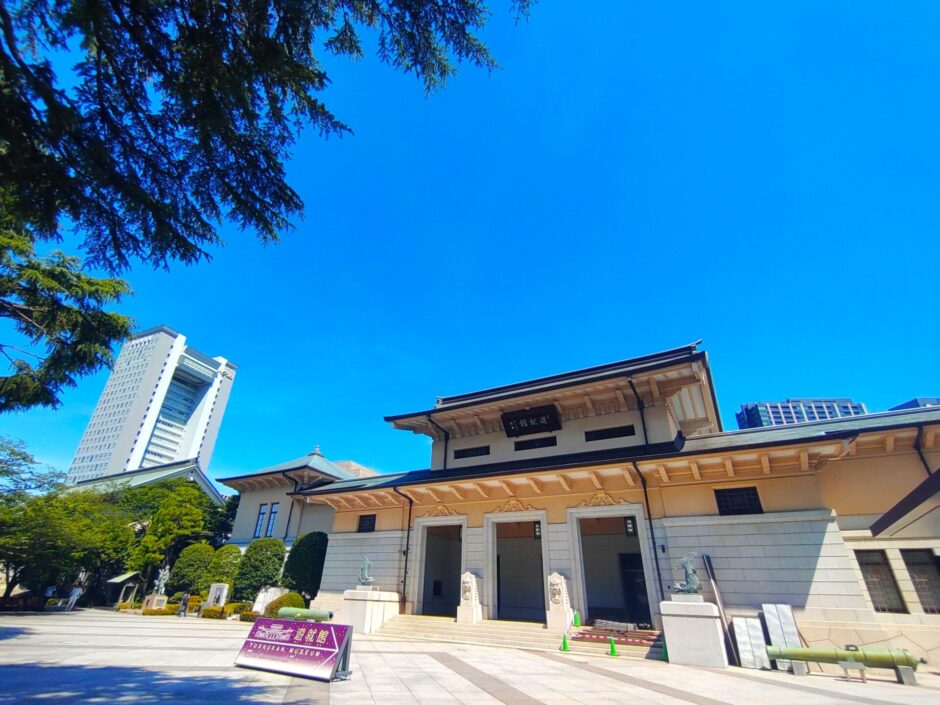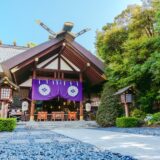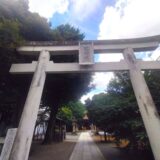目次
- 【Yushukan Museum summary】
- 【Yushukan Museum Type 52 Zero Fighter】
- 【Yushukan Museum Suisei (D4Y) dive bomber・Ohka (Model 11) suicide attack flying bomb】
- 【Yushukan Museum Kaiten Type 1】
- 【Yushukan Museum 1F Tea house Yui】
- 【Yushukan Museum Statue of Kamikaze Pilots】
- 【Yushukan Museum Statue of Mother】
- 【Sacred Pond Garden】
- 【Yushukan Museum Nearby attractions】
- 【Yushukan Museum Access】
- Manager’s Comments
- Yushukan Museum
【Yushukan Museum summary】
![Yushukan Museum and Kamiike Garden [Tokyo] 23740271 m 160x160 - Yushukan Museum and Kamiike Garden [Tokyo]](https://japan-shrine.info/wp-content/uploads/23740271_m-160x160.jpg) Yasukuni-jinja Shrine [Tokyo]
Yasukuni-jinja Shrine [Tokyo]
The Yushukan Museum, located on the grounds of Yasukuni Shrine, is the “first and oldest military museum” in Japan, opened in 1882 to exhibit items related to the war dead. Strictly speaking, it is not a museum, as the Museum Law does not apply to it. After the war, the museum was confiscated by GHQ and leased to Fukoku Mutual Life Insurance Company, and in 2002 (Heisei 14), renovation of the main building and expansion of the new building were completed due to the aging of the museum.
※Please note that there are limited areas in the museum where photographs may be taken.
【Yushukan Museum Type 52 Zero Fighter】
Upon entering the entrance, the Type 52 Zero Fighter (restored aircraft) is first on display.
![Yushukan Museum and Kamiike Garden [Tokyo] DSC 1570 1024x768 - Yushukan Museum and Kamiike Garden [Tokyo]](https://japan-shrine.info/wp-content/uploads/DSC_1570-1024x768.jpg)
The developer is Mitsubishi Heavy Industries, which still exists today and is called “Zero Fighter.
【Yushukan Museum Suisei (D4Y) dive bomber・Ohka (Model 11) suicide attack flying bomb】
![Yushukan Museum and Kamiike Garden [Tokyo] DSC 1577 1 1024x768 - Yushukan Museum and Kamiike Garden [Tokyo]](https://japan-shrine.info/wp-content/uploads/DSC_1577-1-1024x768.jpg)
Ohka (Model 11) is a small aerial suicide attack weapon with a large armor-piercing bomb mounted in the nose section, which is suspended from the mother plane, separated and launched near the target, and guided by the crew to hit the target.
【Yushukan Museum Kaiten Type 1】
![Yushukan Museum and Kamiike Garden [Tokyo] DSC 1581 1024x768 - Yushukan Museum and Kamiike Garden [Tokyo]](https://japan-shrine.info/wp-content/uploads/DSC_1581-1024x768.jpg)
The Kaiten Type 1 is a suicide attack weapon that is modified from a very large torpedo and is guided by the crew to strike the target.
Although I have only shown weapons, this is because it was a place where photography was allowed. Inside the museum, there are many wills, belongings, and photographs of those who died in the war, so you will probably spend more time there than in the museum. When you go to the exit, there is a souvenir shop, and you will come back to the first Zero fighter plane place.
【Yushukan Museum 1F Tea house Yui】
The coffee shop is located next to the Zero fighter plane at the entrance. The signature menu item is “Navy Curry,” which was eaten by servicemen of the Imperial Japanese Navy during their voyages.
![Yushukan Museum and Kamiike Garden [Tokyo] DSC 1582 1 1024x768 - Yushukan Museum and Kamiike Garden [Tokyo]](https://japan-shrine.info/wp-content/uploads/DSC_1582-1-1024x768.jpg)
I ordered the Navy Curry as a commemorative dish, which seems to be a faithful reproduction of the recipe and ingredients of the time.
【Yushukan Museum Statue of Kamikaze Pilots】
There are several statues in front of the Yushukan Museum. They were created as an expression of condolence and a prayer for the repose of the souls of the souls of his students who volunteered to become reserve naval flight students and were lost in the sky when he was a professor at Tokyo Art School, which is now Tokyo National University of Fine Arts and Music.
![Yushukan Museum and Kamiike Garden [Tokyo] DSC 1585 1024x768 - Yushukan Museum and Kamiike Garden [Tokyo]](https://japan-shrine.info/wp-content/uploads/DSC_1585-1024x768.jpg)
The sculptor Kitamura Seibo’s “Naval Aviation Reserve Student Statue (Yufu)”.
【Yushukan Museum Statue of Mother】
It was erected in 1974 by children who had grown up to adulthood (the Youth Division of the Japan Bereaved Family Association) to honor and thank their mothers who had endured the hardships of the postwar period and raised them well.
![Yushukan Museum and Kamiike Garden [Tokyo] DSC 1587 1024x761 - Yushukan Museum and Kamiike Garden [Tokyo]](https://japan-shrine.info/wp-content/uploads/DSC_1587-1024x761.jpg)
Sculptor Takashi Miyamoto’s “Statue of Mother” depicts a mother who lost her husband in the war and survives strongly with her three orphaned children.
【Sacred Pond Garden】
Located just behind Yasukuni Shrine, there is a garden that is not surprisingly well known.
![Yushukan Museum and Kamiike Garden [Tokyo] DSC 1603 1024x768 - Yushukan Museum and Kamiike Garden [Tokyo]](https://japan-shrine.info/wp-content/uploads/DSC_1603-1024x768.jpg)
It was built in the early Meiji period (1868-1912), and was restored and maintained in 1999. The elegant carp swimming in the water is a relaxing sight to behold.
![Yushukan Museum and Kamiike Garden [Tokyo] DSC 1589 1024x768 - Yushukan Museum and Kamiike Garden [Tokyo]](https://japan-shrine.info/wp-content/uploads/DSC_1589-1024x768.jpg)
Surrounding the garden are three teahouses, Gyoun-tei, Seishintei, and Yasusen-tei, built from prewar to mid-Showa period, which are beautiful during the cherry blossom and autumn foliage seasons.
【Yushukan Museum Nearby attractions】
Yasukuni Shrine, Tsukudo Shrine, Imperial Palace
【Yushukan Museum Access】
Manager’s Comments
The year 2025 is the 80th anniversary of the end of the war, and I visited Yasukuni Shrine and the Yushukan once again. I believe that this visit to the Yushukan will give us a chance to reconsider the preciousness of peace and the importance of maintaining it. The wills and belongings of those who died in the war remind us of the tragedy and cruelty of war. On the other hand, some people interpret them as glorifying Japanese militarism, so it is better to see them for yourself after visiting Yasukuni Shrine.
Yasukuni Shrine, 3-1-1 Kudan-kita, Chiyoda-ku, Tokyo 102-8246, Japan
※Free parking for visitors to Yasukuni Shrine.
 Tour of Japanese shrines and temples
Tour of Japanese shrines and temples 

![Yushukan Museum and Kamiike Garden [Tokyo] 23740271 m 520x300 - Yushukan Museum and Kamiike Garden [Tokyo]](https://japan-shrine.info/wp-content/uploads/23740271_m-520x300.jpg)
![Yushukan Museum and Kamiike Garden [Tokyo] DSC 1621 1 520x300 - Yushukan Museum and Kamiike Garden [Tokyo]](https://japan-shrine.info/wp-content/uploads/DSC_1621-1-520x300.jpg)
![Yushukan Museum and Kamiike Garden [Tokyo] DSC 0348 520x300 - Yushukan Museum and Kamiike Garden [Tokyo]](https://japan-shrine.info/wp-content/uploads/DSC_0348-520x300.jpg)
![Yushukan Museum and Kamiike Garden [Tokyo] 23740271 m 150x150 - Yushukan Museum and Kamiike Garden [Tokyo]](https://japan-shrine.info/wp-content/uploads/23740271_m-150x150.jpg)
![Yushukan Museum and Kamiike Garden [Tokyo] DSC 0348 150x150 - Yushukan Museum and Kamiike Garden [Tokyo]](https://japan-shrine.info/wp-content/uploads/DSC_0348-150x150.jpg)
![Yushukan Museum and Kamiike Garden [Tokyo] 24270958 m 150x150 - Yushukan Museum and Kamiike Garden [Tokyo]](https://japan-shrine.info/wp-content/uploads/24270958_m-150x150.jpg)
![Yushukan Museum and Kamiike Garden [Tokyo] DSC 1218 150x150 - Yushukan Museum and Kamiike Garden [Tokyo]](https://japan-shrine.info/wp-content/uploads/DSC_1218-150x150.jpg)

